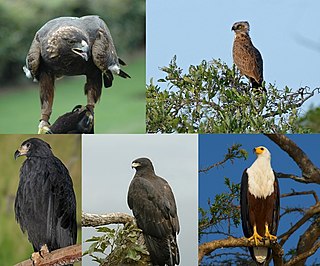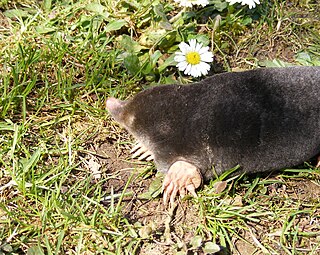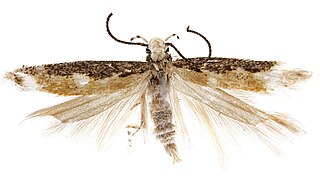
A definition is a statement of the meaning of a term. Definitions can be classified into two large categories: intensional definitions, and extensional definitions. Another important category of definitions is the class of ostensive definitions, which convey the meaning of a term by pointing out examples. A term may have many different senses and multiple meanings, and thus require multiple definitions.

Eagle is the common name for many large birds of prey of the family Accipitridae. Eagles belong to several groups of genera, some of which are closely related. Most of the 60 species of eagle are from Eurasia and Africa. Outside this area, just 14 species can be found—2 in North America, 9 in Central and South America, and 3 in Australia.
Genus is a taxonomic rank used in the biological classification of living and fossil organisms as well as viruses. In the hierarchy of biological classification, genus comes above species and below family. In binomial nomenclature, the genus name forms the first part of the binomial species name for each species within the genus.

In taxonomy, binomial nomenclature, also called binominal nomenclature or binary nomenclature, is a formal system of naming species of living things by giving each a name composed of two parts, both of which use Latin grammatical forms, although they can be based on words from other languages. Such a name is called a binomial name, a binomen, binominal name or a scientific name; more informally it is also historically called a Latin name.

The lagomorphs are the members of the taxonomic order Lagomorpha, of which there are two living families: the Leporidae and the Ochotonidae (pikas). The name of the order is derived from the Ancient Greek lagos + morphē. There are 110 recent species of lagomorph of which 109 are extant, including 34 species of pika, 42 species of rabbit, and 33 species of hare.

Moles are small mammals adapted to a subterranean lifestyle. They have cylindrical bodies, velvety fur, very small, inconspicuous eyes and ears, reduced hindlimbs, and short, powerful forelimbs with large paws adapted for digging.

Columbidae is a bird family consisting of pigeons and doves. It is the only family in the order Columbiformes. These are stout-bodied birds with short necks and short slender bills that in some species feature fleshy ceres. They primarily feed on seeds, fruits, and plants. The family occurs worldwide, but the greatest variety is in the Indomalayan and Australasian realms.

Anseriformes is an order of birds also known as waterfowl that comprises about 180 living species of birds in three families: Anhimidae, Anseranatidae, and Anatidae, the largest family, which includes over 170 species of waterfowl, among them the ducks, geese, and swans. Most modern species in the order are highly adapted for an aquatic existence at the water surface. With the exception of screamers, males have penises, a trait that has been lost in the Neoaves. Due to their aquatic nature, most species are web-footed.

Starlings are small to medium-sized passerine birds in the family Sturnidae. The name "Sturnidae" comes from the Latin word for starling, sturnus. Many Asian species, particularly the larger ones, are called mynas, and many African species are known as glossy starlings because of their iridescent plumage. Starlings are native to Europe, Asia and Africa, as well as northern Australia and the islands of the tropical Pacific. Several European and Asian species have been introduced to these areas as well as North America, Hawaii and New Zealand, where they generally compete for habitats with native birds and are considered to be invasive species. The starling species familiar to most people in Europe and North America is the common starling, and throughout much of Asia and the Pacific, the common myna is indeed common.
In biology, a monotypic taxon is a taxonomic group (taxon) that contains only one immediately subordinate taxon. A monotypic species is one that does not include subspecies or smaller, infraspecific taxa. In the case of genera, the term "unispecific" or "monospecific" is sometimes preferred. In botanical nomenclature, a monotypic genus is a genus in the special case where a genus and a single species are simultaneously described. In contrast an oligotypic taxon contains more than one but only a very few subordinate taxa.

In zoological nomenclature, a type species is the species name with which the name of a genus or subgenus is considered to be permanently taxonomically associated, i.e., the species that contains the biological type specimen(s). A similar concept is used for suprageneric groups and called a type genus.

The Moscow Monorail is a 4.7-kilometre-long (2.9 mi) monorail line located in the North-Eastern Administrative Okrug of Moscow, Russia. It runs from the Timiryazevskaya via Fonvisinskaya and VDNHa metro stations to Sergeya Eisensteina street. The monorail line currently has six stations. Planning of the monorail in Moscow started in 1998. This was a unique project for Russian companies, which did not have prior experience in building monorails. 6,335,510,000 rubles were spent by the city of Moscow on the monorail construction.

Sergei Mikhailovich Slonimsky was a Russian and Soviet composer, pianist and musicologist.

In biological classification, taxonomic rank is the relative level of a group of organisms in an ancestral or hereditary hierarchy. One common system used includes a tree of species, genus, family, order, class (clade), phylum, kingdom, domain. The study of taxonomy is also called cladistics.

Ulitsa Sergeya Eyzensteyna is the eastern terminus of the Moscow Monorail. It is located in the Ostankinsky District of the North-Eastern Administrative Okrug of Moscow.

Vystavochny Tsentr is a Moscow Monorail station in the Ostankinsky District, North-Eastern Administrative Okrug, Moscow, Russia. The station is near the main entrance of VDNKh, which was named the All-Russia Exhibition Center in 1992–2014, hence the station name.

Ulitsa Akademika Korolyova is a station of the Moscow Monorail. It is located in the Ostankino District of the North-Eastern Administrative Okrug of Moscow.

Timiryazevskaya is the western terminus of the Moscow Monorail. It is located in the Butyrsky District of the North-Eastern Administrative Okrug of Moscow, 50 metres (160 ft) away from Moscow Metro station Timiryazevskaya.

Lyudmila Alexandrovna Shagalova was a Russian film supporting actress, active during the Soviet era. She was named a People's Artist of Russia in 1977.

Gelechiinae is a subfamily of moths in the family Gelechiidae. It was described by Henry Tibbats Stainton in 1854.
















